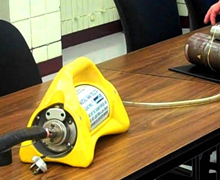Radiography Testing (RT)
 RT involves the use of penetrating gamma- or X-radiation to examine material's and product's defects and internal features. An X-ray machine or radioactive isotope is used as a source of radiation and inspection tool. Radiation is directed through a part and onto film or other media. The resulting shadowgraph shows the internal features and soundness of the part. Material thickness and density changes are indicated as lighter or darker areas on the film. The darker areas in the radiograph below represent internal voids in the component. RT involves the use of penetrating gamma- or X-radiation to examine material's and product's defects and internal features. An X-ray machine or radioactive isotope is used as a source of radiation and inspection tool. Radiation is directed through a part and onto film or other media. The resulting shadowgraph shows the internal features and soundness of the part. Material thickness and density changes are indicated as lighter or darker areas on the film. The darker areas in the radiograph below represent internal voids in the component.
COURSE OBJECTIVE:
This is a course for all who require an in-depth knowledge of interpretation and evaluation of radiographs of weld (and castings if required by the client). The course concentrates on radiographic film viewing, RT application techniques, evaluation of welds, standards, codes and procedures for radiography etc.
COURSE CONTENT (Modified as per client’s job needs):
Review of the Radiographic variables related to Film Interpretation, Radiation, Energy –v/s- Intensity, Quality v/s quantity, Wavelength, Electromagnetic wave spectrum, Sources (X-ray/gamma-ray), Source to film distance, Film to object distance, Source/Target Size, Geometric un-sharpness, Alignment, Material, Thickness, Type (Density), Configuration, Process (Castings, Forgings, Welds, Etc.), Speed, Graininess, Handling, Screens, Density, Exposure/Time, Fog density equation, Radiographic viewing, Film illuminator requirements, High intensity illuminator, Background lighting, Multiple/composite viewing, Penetrameter placement, Film Id, Location markers, Dark adaptation/visual acuity, Densitometer operation Calibration maintenance, Density measurements, Radiographic Image Quality, Radiographic Contrast, Film Contrast, Subject Contrast, Radiographic Sensitivity, Definition, Latitude, Image Quality Indicators (Penetrameters), Types, Construction, Materials, Dimensions, Identification, Placement, Shims, Exposure techniques, Multiple film, Coverage, Superimposing films, Single wall exposure, Single wall view, Double wall exposure, Single wall view, Double wall exposure, Double wall view, Panoramic exposure, General discontinuities, Weld, Artifacts Assemblies, Composites, Miscellaneous Products, Radiographic Artifacts, Prior to Processing Scratches, , Crimp Marks, Pressure Marks, Static Marks, Fog, Screen Defects, Light Leaks, Finger Marks, During Processing Chemical Spill Spots, Dirt, Pi Lines, Pressure Marks, Overlaps, After Processing Scratches, Dirt, Creases, Codes, Procedures & Written Practices, ASME Section V, API 1104, AWS D1.1, Radiographic Report Forms, Purpose of Report Forms, Requirements.
Practical’s
Introduction to RT equipment, Various sections and salient features of film, Checking for quality of film – sensitivity and density, HD curve, Determining / Setting up Geometric Un-sharpness Ug, Identifying the item radiographed, Use of a slide rule, Interpreting radiograph.
|